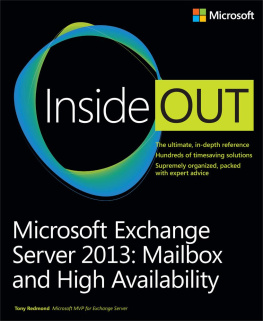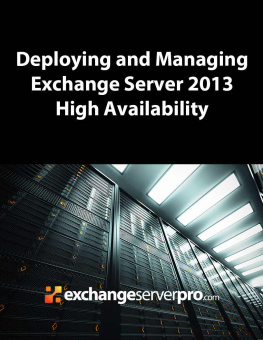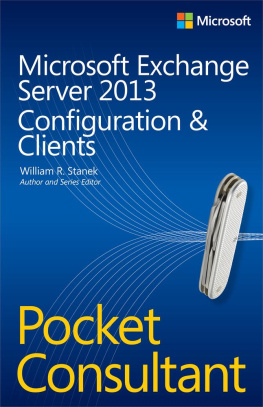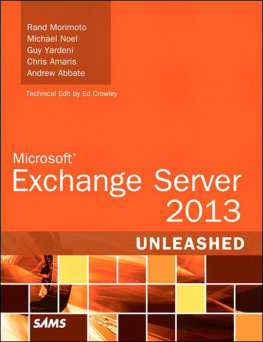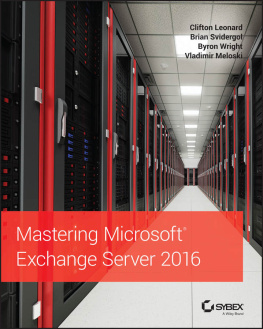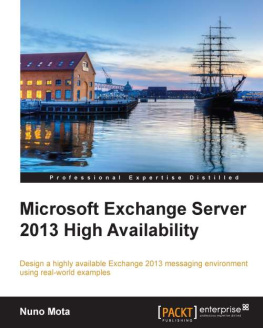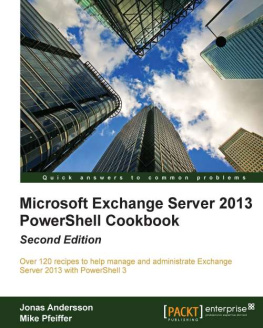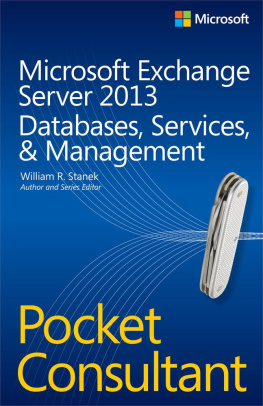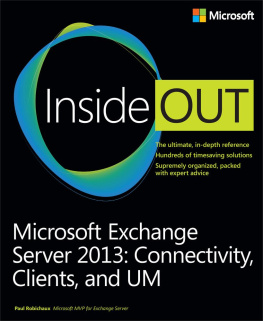If you purchased this ebook directly from oreilly.com, you have the following benefits:
If you purchased this ebook from another retailer, you can upgrade your ebook to take advantage of all these benefits for just $4.99. to access your ebook upgrade.
Foreword for Exchange 2013 Inside Out books
Those seeking an in-depth tour of Exchange Server 2013 couldnt ask for better guides than Tony Redmond and Paul Robichaux. Tony and Paul have a relationship with the Exchange team that goes back two decades, to the days of Exchange 4.0. Few people have as much practical knowledge about Exchange, and even fewer have the teaching skills to match. You are in good hands.
Over the past few years, we have seen significant changes in the way people communicate; a growing number of devices, an explosion of information, increasingly complex compliance requirements, and a multigenerational workforce. This world of communication challenges has been accompanied by a shift toward cloud services. As we designed Exchange 2013, the Exchange team worked hard to build a product and service that address these challenges. As you read these books, youll get an up-close look at the outcome of our efforts.
Microsoft Exchange Server 2013 Inside Out: Mailbox and High Availability covers foundational topics such as the Exchange Store, role-based access control (RBAC), our simplified approach to high availability, and the new public folder architecture. It also covers our investments in eDiscovery and in-place hold. As you read, youll see how Exchange 2013 helps you achieve world-class reliability and provides a way to comply with internal and regulatory compliance requirements without the need for third-party products.
Microsoft Exchange Server 2013 Inside Out: Connectivity, Clients, and UM explores the technologies that give users anywhere access to their email, calendar, and contacts across multiple devices. It also explains how to protect your email environment from spam, viruses, and other threats and describes how Exchange 2013 can connect with Office 365 so you can take advantage of the power of the cloud.
From our new building-block architecture to data loss prevention, theres a lot to explore in the newest version of Exchange. I hope that as you deploy and use Exchange 2013, youll agree that this is an exciting and innovative release.
Enjoy!
Rajesh Jha
Corporate Vice President - Exchange
Microsoft Corporation
Introduction
This book is for experienced Exchange administrators who want to get inside the soul of Exchange Server 2013, the latest version of the Microsoft enterprise messaging server first released in October 2012 and updated on a frequent basis since. You might learn how to work with Exchange 2013 by reading this book, but I sincerely doubt that this will happen simply because I have written it with experience in mind.
The book does not cover every possible topic relating to Exchange 2013. In fact, it focuses primarily on the Mailbox server role. Let me explain why. After completing Microsoft Exchange Server 2010 Inside Out (Microsoft Press, 2010), it became very clear that attempting to cover all of a complex product such as Exchange in any depth in just one book was a fools errand. There are too many details to master, too much work to do, too much information that can only be skimmed over to keep to a reasonable page count. The result would probably be a book that weighs 2 kilos, spanning 1,400 pages that takes 2 years to write. All in all, an unacceptable situation in both commercial and practical terms.
Paul Robichaux and I ran a number of Exchange 2010 Maestro seminars in the 20102011 period. Despite the infamous cockroach sandwich affair, the events were good fun, and we enjoyed discussing the technology in some depth, even if we tended to ramble on at times. Brian Desmond, an Active Directory MVP who did an excellent job of lab master and stand-in speaker when required, helped us. Because we worked well together and because Paul has an excellent record of writing both books and articles, it seemed like a good idea to consider a joint approach for Microsoft Exchange Server 2013 Inside Out . We arrived at the basic idea quicklywe would split coverage into the two server roles. Id write about the Mailbox role and Paul took on client access, including all the various clients Exchange supports, and unified messaging, which, strictly speaking, is part of an Exchange 2013 Mailbox server. However, Paul is an acknowledged expert in this space, and it would have made no sense to have me write about a subject of which Paul is the master.
Because Exchange 2013 is an evolution of Exchange 2010, we decided to use Microsoft Exchange Server 2010 Inside Out as the base for the new book. An evolution it might be, but an extensive level of change at the detail level exists in Exchange 2013. The upshot is that Im not sure how much of that book remains in the current textmaybe 20 percent. One thing I am glad of is that we did not rush to press after Exchange 2013 first appeared. Given the amount of change that has occurred in updates from Microsoft since, a book that describes the release to manufacturing (RTM) version of Exchange 2013 would have been obsolete very soon after publication. We hope that these volumes will last longer.
I hope that you enjoy this book and that youll read it alongside Pauls Microsoft Exchange Server 2013 Inside Out: Clients, Connectivity, and UM . The two books really do go together. Paul has scrutinized every word in this book and I have done the same for his. We therefore share the blame for any error you might find.
Acknowledgments
I owe enormous thanks to the many people who agreed to look over chapters or portions of the book. Each has deep expertise in specific areas and all contributed greatly to eradicating errors and increasing clarity. These folks include Sanjay Ramaswamy, Jrgen Hasslauer, David Espinoza, William Rall, Todd Luttinen, Tim McMichael, Vineetha Kalvakunta, Fred Monteiro da Cruz Filho, Kanika Ramji, Lokesh Bhoobalan, Astrid McClean, Alfons Staerk, Kern Hardman, Andrew Friedman, Abram Jackson, and Scott Schnoll. Even if they didnt realize it, many of the Exchange MVPs played their part in improving the book by prompting me to look into topics that I had forgotten to cover. I should also acknowledge the huge contribution made by my editor, Karen Szall. We fought many times about page counts, content, and too many other topics to list here but always kept the project moving.
I apologize sincerely if I have omitted to mention anyone who has contributed to making the text of the book as accurate and as informative as possible.
Errata & book support
Weve made every effort to ensure the accuracy of this book and its companion content. Any errors that have been reported since this book was published are listed on our Microsoft Press site at oreilly.com:
http://aka.ms/ExIOv1/errata
If you find an error that is not already listed, you can report it to us through the same page.
If you need additional support, email Microsoft Press Book Support at .
Please note that product support for Microsoft software is not offered through the addresses above.

